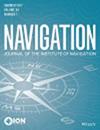使用图卷积神经网络学习智能手机GNSS定位校正
IF 2
3区 地球科学
Q1 ENGINEERING, AEROSPACE
引用次数: 0
摘要
智能手机接收器包括目前全球生产的约15亿个全球导航卫星系统接收器。与商用接收器相比,智能手机接收器提供的测量信号水平较低,噪声较高。由于尺寸、重量、功耗和成本的限制,这些接收器很难实现精确定位,特别是在城市环境中。传统的全球定位系统测量是通过加权最小二乘和卡尔曼滤波等基于模型的方法处理的。虽然基于模型的方法可以以后处理方式提供米级定位精度,但这些方法需要对相应的噪声模型进行强有力的假设,并且需要手动调整协方差等参数。相比之下,已经提出的基于学习的方法对数据结构的假设较少,并且可以准确地模拟特定于环境的错误。然而,与基于模型的方法相比,这些方法的准确性较低,并且对初始化很敏感。在本文中,我们提出了一种混合学习位置校正框架,它对应于真实接收器位置与估计位置之间的偏移量。对于基于学习的方法,我们提出了一种图卷积神经网络(GCNN),它可以学习具有多星座和多频率信号的不同图结构。为了更好地初始化GCNN,我们使用卡尔曼滤波器来估计粗接收器位置。然后,我们使用这个粗糙的接收器位置来调整图的输入特征。我们在谷歌智能手机分米挑战赛的真实数据集上测试了我们提出的方法,并显示了比基于模型的方法(如加权最小二乘法和卡尔曼滤波方法)更好的定位性能。本文章由计算机程序翻译,如有差异,请以英文原文为准。
Learning GNSS Positioning Corrections for Smartphones Using Graph Convolution Neural Networks
Abstract
Smartphone receivers comprise approximately 1.5 billion global navigation satellite system receivers currently manufactured worldwide. Smartphone receivers provide measurements with lower signal levels and higher noise than commercial receivers. Because of constraints on size, weight, power consumption, and cost, it is challenging to achieve accurate positioning with these receivers, particularly in urban environments. Traditionally, global positioning system measurements are processed via model-based approaches, such as weighted least-squares and Kalman filtering approaches. While model-based approaches can provide meter-level positioning accuracy in a postprocessing manner, these approaches require strong assumptions on the corresponding noise models and require manual tuning of parameters such as covariances. In contrast, learning-based approaches have been proposed that make fewer assumptions about the data structure and can accurately model environment-specific errors. However, these approaches provide lower accuracy than model-based methods and are sensitive to initialization. In this paper, we propose a hybrid framework for learning position correction, which corresponds to the offset between the true receiver position and the estimated position. For a learning-based approach, we propose a graph convolution neural network (GCNN) that can learn different graph structures with multi-constellation and multi-frequency signals. For better initialization of the GCNN, we use a Kalman filter to estimate a coarse receiver position. We then use this coarse receiver position to condition the input features to the graph. We test our proposed approach on real-world data sets from the Google Smartphone Decimeter Challenge and show improved positioning performance over model-based methods such as the weighted least-squares and Kalman filter methods.求助全文
通过发布文献求助,成功后即可免费获取论文全文。
去求助
来源期刊

Navigation-Journal of the Institute of Navigation
ENGINEERING, AEROSPACE-REMOTE SENSING
CiteScore
5.60
自引率
13.60%
发文量
31
期刊介绍:
NAVIGATION is a quarterly journal published by The Institute of Navigation. The journal publishes original, peer-reviewed articles on all areas related to the science, engineering and art of Positioning, Navigation and Timing (PNT) covering land (including indoor use), sea, air and space applications. PNT technologies of interest encompass navigation satellite systems (both global and regional), inertial navigation, electro-optical systems including LiDAR and imaging sensors, and radio-frequency ranging and timing systems, including those using signals of opportunity from communication systems and other non-traditional PNT sources. Articles about PNT algorithms and methods, such as for error characterization and mitigation, integrity analysis, PNT signal processing and multi-sensor integration, are welcome. The journal also accepts articles on non-traditional applications of PNT systems, including remote sensing of the Earth’s surface or atmosphere, as well as selected historical and survey articles.
 求助内容:
求助内容: 应助结果提醒方式:
应助结果提醒方式:


